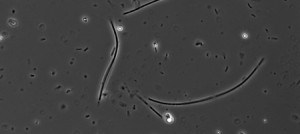joint genome institute
Brown tide culprit sequenced: Genome of the first of algal bloom species
Algae play key roles in the global carbon cycle, helping sequester significant amounts of carbon. Some algal species can bloom, or become so numerous, that they discolor coastal waters and reduce the amount of light and oxygen available in the e…
The most genes in an animal? Tiny crustacean holds the record
Scientists have discovered that the animal with the most genes–about 31,000–is the near-microscopic freshwater crustacean Daphnia pulex, or water flea.
By comparison, humans have about 23,000 genes. Daphnia is the first crustacean to have it…
Massive Daphnia genome leads to understanding gene-environment interactions
DURHAM, N.H. — From an environmental perspective, Daphnia pulex — the waterflea — is the best-studied organism on the planet. Scientists know how this species responds to pollution, predators, day and night, making it an important model for…
Team looks to the cow rumen for better biofuels enzymes
CHAMPAIGN, Ill. — When it comes to breaking down plant matter and converting it to energy, the cow has it all figured out. Its digestive system allows it to eat more than 150 pounds of plant matter every day. Now researchers report that they …
A new branch on the tree of life
The family tree of life has a newly discovered branch. Genetic studies comparing mitochondrial DNA have revealed that what has long been thought to be the group from which insects arose, the Collembola — wingless hexapods (or “six legs”) commonly called springtails — turns out not to be closely related to insects after all. Instead, these creatures belong to a separate evolutionary lineage that predates even the separation of insects and crustaceans.
Slice that DNA carefully
 The genome of the pufferfish, a Japanese delicacy, is teaching researchers about the more complex genetic makeup of humans. The pufferfish, or Fugu, has about the same number of genes as humans, but without most of the repetitive “junk” DNA found in naked apes, researchers at the Joint Genome Institute in Walnut Creek, California, report. Fugu can pack a lethal tetrodotoxin whallop, but manages to do so with the smallest genome of any vertebrate. The findings were detailed in the journal Science and reported on by the Associated Press.
The genome of the pufferfish, a Japanese delicacy, is teaching researchers about the more complex genetic makeup of humans. The pufferfish, or Fugu, has about the same number of genes as humans, but without most of the repetitive “junk” DNA found in naked apes, researchers at the Joint Genome Institute in Walnut Creek, California, report. Fugu can pack a lethal tetrodotoxin whallop, but manages to do so with the smallest genome of any vertebrate. The findings were detailed in the journal Science and reported on by the Associated Press.

